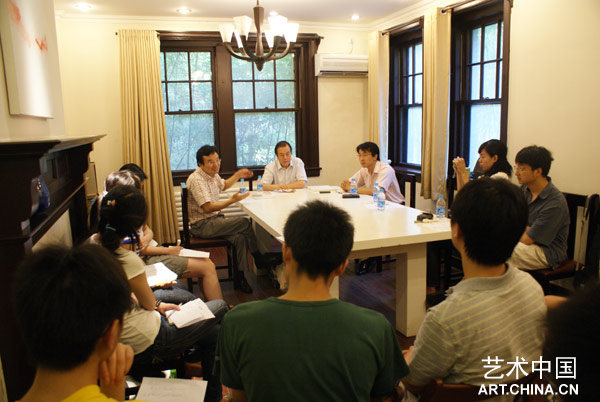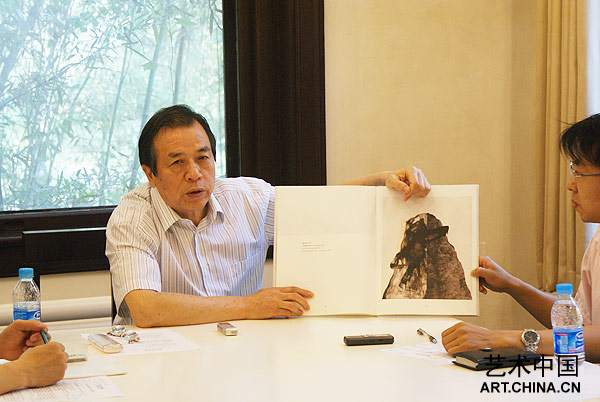|
尚揚:《董其昌計劃》當代藝術的中國方式(下)
2009年6月14日下午15:00,“藝術中國講壇走進校園系列——《董其昌計劃》:當代藝術的中國方式”在北京大學燕南園52號院舉辦。
藝術中國講壇走進校園系列——
講座主題: 《董其昌計劃》:當代藝術的中國方式
時間:2009年6月14日(周日)15:00-16:30
地點:北京大學燕南園52號院
演講人:尚揚 先生 中國油畫學會副主席,首都師范大學美術學院教授 【尚揚簡介】
彭鋒 博士 北京大學美學與美育研究中心教授
主持人:于洋 博士 藝術中國學術主持
內容介紹:《董其昌計劃》是著名油畫家尚揚先生的最新系列作品,也是他從藝50余年以來的首次個展的題目。自2002年末開始大量創作的系列中,尚揚越來越多地將機械復制的現成圖像拼貼、印制于業已成熟的“大風景”,深刻地探討了自足、和諧、統一的中國本土邏輯,被當代語境碎片化、平面化、沖突化的文化命題。“一定要在現代性上有所貢獻”既是尚揚對自身藝術追求的嚴肅思考,更對當下特殊時期的中國當代藝術發展具有十分積極的現實意義。本次講座以對談方式展開,圍繞中國現代油畫的問題進行深入解讀,畫家與學者的思想交鋒,時代與風格的多元演繹,使這次講座精彩紛呈。
更多現場圖片
 講座現場
講座現場
 講座現場
講座現場
'Chinese Way of Modern Art' seminar held at Peking University
In the quiet and green Yannan Park of Peking University, a small, old-fashioned yard stands among swaying bamboos. This is yard No. 52, where artist Shang Yang and Professor Peng Feng from the Research Center for Aesthetics and Aesthetics Education at Peking University shared their views in a seminar about Chinese modern art.
“The Dong Qichang Project”: a reflection on the relationship between humans and nature
"The Dong Qichang Project" is Shang's first solo exhibition. Dong Qichang was a painter, calligrapher and an experienced art critic during the Ming dynasty. He lived in an era when people preferred to work spontaneously instead of making precise schedules. Shang places the modern word "project" beside the name of the traditional Chinese artist in the title of his exhibition, thus creating a sense of contradiction and expressing his views regarding people's destructive power on nature today.
Shang showed the audience his ideas through an album of paintings. One picture in the album was a traditional Chinese painting of a mountain and a river, cut in half. One half had been scribbled over in thick, black lines. Shang said the lines represent the dramatic change people impose on nature after science and technology have developed to a certain level. This change, Shang said, is perpetually altering nature and generating pungent and ceaseless pains against people. Shang hopes to bring people's attention to this universal problem through his album. Shang's works in the album were created from 2002 to 2009 as a continuation of his previous concern about people and nature. The exhibition is now on show in Tiananmen Time Fashion & Art Center, No. 23 Qianmen Street.
From the West to the East: Chinese way of modern art
The late renowned president of Peking University, Cai Yuanpei, advanced the idea of "adopting an all-embracing doctrine" to run the college in 1916. This pioneering concept convened academic theories and practices from both the West and the East. Traditional and modern thoughts collided with each other and brought China to a new age. Ninety-three years later, Chinese modern art is forced to find its own way, after years of following the West.
Shang helped to explain the development of Chinese modern art in general. Chinese art has served as a tool for politics since 1949. Walking away from the restraints of ideology in the 1980s, it began to adapt various western art theories. In the 1990s, artists paid more attention to individual exploration and sought international acknowledgement. So far in the 21st century, Chinese modern art is seeking to develop a unique expression and become more pluralistic. Peng summarized Chinese modern art as "looking at others," "being looked at by others," and "looking at itself."
Peng says China initially modernized through Westernization, which has caused a lot of contradictions with traditional Chinese culture. Chinese modern art has developed in much the same way. China's art and artists are absent from the 20th century. However, with globalization, the world is closely connected and cultures are blending into new forms. Chinese artists are now voluntarily turning to their abundant aesthetic and cultural heritage. Some of them use typical Chinese symbols to appeal to westerners, while others deliberately choose them to uniquely express their concern about problems happening in Chinese society.
China can neither refuse the ubiquity of western culture, nor completely give up the original Chinese taste. Moreover, the elaboration of art today includes artists' social responsibility instead of "art for art's sake." According to Shang and Peng, the "Chinese way of modern art" can be concluded as, "reflecting and solving China's problems by Chinese people with Chinese wisdom."
|

